Tens of thousands of people live this way and everything has been adapted to a waterborne way of life. Door to door sellers of produce, household goods, clothing, charcoal, ice – everything floats directly to your door.
Children attend school in floating barges and play football on the roofs of their schools in fenced in areas. Churches, stores, work areas, repair shops all float. There are two reasons. First, these people make their living from the water, mostly as fishers. Secondly, they are largely Vietnamese and are landless, so this is one of few alternatives. And above all, a floating village makes complete sense when you realize the water table fluctuates by as much as ten meters.
The Tonle Sap Lake floods annually and expands beyond its normal 1,300 square kilometer borders to nearly nine times its size. At the height of the flooding in August, brought on by the combination of the monsoon and the snowmelt of the Himalayas delivered by the Mekong River, 60% of Cambodia’s land mass is covered with water. And it is around this swollen lake that a miracle occurs: little fingerlings grow up to be adult fish because they find refuge from predators in the shallow flooded forest areas.
Tonle Sap is perhaps Cambodia’s richest natural asset. It is the second most biodiverse natural freshwater body in the world, home to nearly 400 aquatic species. Annually, nearly 340 million tons of fish are harvested from its waters, serving as the livelihood and nutritional backbone of the Cambodian people.
Tyler, Katie and I got a good up close view of life on the water during our trip last Wednesday when we crossed the northern tip of the Tonle Sap and cruised down the Sangker River on the way to Battambang. This was the second time I’d done the cruise which is conducted on a non-US Coast Guard approved boat. Ignorantly charitable, the safest thing about it was that it had no life preservers. And the ultra hard wooden seats made the journey anything but comfortable. This boat dredged up images and stories of the many boating disasters that we often hear about coming from SE Asia.
Safety and comfort aside, it was an experience. The first remarkable thing happened in the first hour. The man directly across from me was hit in the back by a largish, two foot long catfish that jumped into our boat. It caused quite a commotion but eventually the crew tossed it back into the water so it could live to fight another day.
We cruised along the Sangker River and passed through floating villages which appeared about every five kilometers. The boat did double duty as a water taxi by uploading and off-loading locals who paddled out in small canoes to board, many with old rice sacks serving as luggage. We stopped halfway, about four hours into the trip, to have lunch on a floating dock. Little did the rest of the westerners on the boat realize there were still four hours to go!
Amazingly, the Lonely Planet Guide to Cambodia lists the trip as 3-5 hours, but longer in the dry season. Well, the water was way up this time and it still took 8 hours. Of course, that did include the 30 minutes or so we were stranded while the crew finally figured out we were out of gas. No problem, just scurry up the bank to buy a five gallon can of petrol from a farmer and we were on the way again. The Cambodians are terribly practical and resourceful people.
It’s been really fun sharing this experience with Tyler and Katie. Both of them exclaim how wonderful this country is, even with its quirks and inconveniences. They really understand why I enjoy it so much and what I mean now when I say it is a different pace of life entirely.
On Saturday, Tyler and Katie bumped into their tuk-tuk driver, Moul, who had taken them around Angkor Wat on the Tuesday before. Amazing! 25o kilometers away and the same guy turns up on our street visiting his family who live the next block down from me. We invited him to join us for dinner that night, as well as Eddie and Marie (Indonesian and French, respectively), our neighbors from across the hall. So we had quite an international gathering with differing degrees of understanding one other. And this was the first time I have cooked Khmer food for a Khmer person - I think it was also the first time Moul had had an American cook for him!
So now we’re back in Phnom Penh after having visited Siem Reap and Angkor Wat temples for two days, then Battambang for two days. The bus rides on Mon and Fri were 6 hours each and the boat ride Wed was 8 hours, so it can be a wearing experience. Each day of travel, however, is part of the experience.
I’ve uploaded several pics on the web from the floating village to share with you. Perhaps you’ll come here one day and see for yourself.



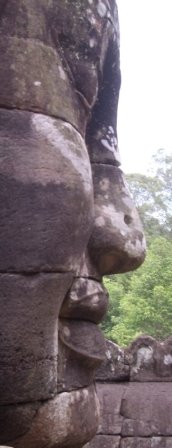


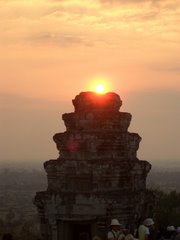
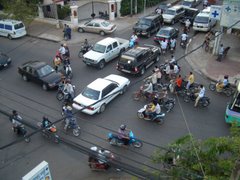
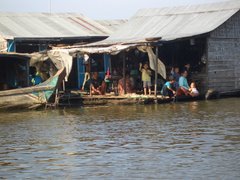
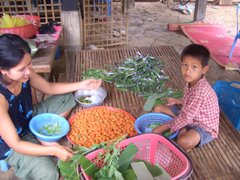
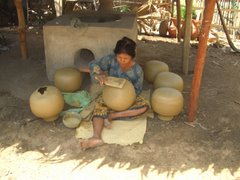
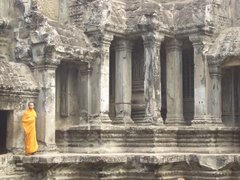

No comments:
Post a Comment